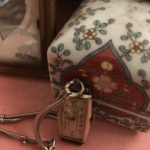
A piece of advice I always give people who want to live lighter on the earth is, “find out how people did things in the old days” (before electricity, cheap long-distance vehicular transport, and so on). This tip also can save you a lot of money and boost your household’s disaster-preparedness (whether “disaster” is a hurricane or other natural disaster, a financial catastrophe such as losing a job, or a personal crisis such as divorce or sudden illness).
In my jewelry box I have a bunch of old watches, most of them inherited from my Mom. The newer ones all need batteries and/or cleaning in order to (possibly) work. Guess which one worked without any visit to the jeweler: the oldest one! A plain old, purely mechanical, wind-it-up-daily, no-battery watch. I’m not sure how old this is but it looks 1920s or ’30s.
I was aware that clocks had been around for centuries. The operate by springs and weights. (If you want a more detailed explanation you’ll have to look elsewhere; that explanation is enough for me!) I always figured that watches (being small versions of clocks) had been invented sometime quite a bit later, maybe around the 1800s. When I did a little research, I learned that watches in some form have actually been around since the 1500s! As a modern person, I’m accustomed to machines that operate electrically or electronically. Though I don’t have detailed knowledge of electricity or electronics, they feel familiar to me anyway, and dare I say mundane; easy to take for granted. In contrast, intricate devices that operate by purely mechanical technology have a breathtakingly mysterious beauty to me.
Humans did a lot without electricity. It’s a useful and empowering exercise to explore how many of your daily needs you could possibly meet without fossil fuels. (Although electricity is not itself a fossil fuel, most electricity is still generated by burning fossil fuels: usually coal or gas. But solar and other non-fossil-generated electricity is becoming a strong contender in some parts of the world!)
So anyway, about the watch in the photo. I had been keeping this watch in my jewelry box. But now it’s a charming addition to my work-desk, serving as a miniature clock.
I have to remember to wind it every day, or it’ll stop running. And then I have to check my computer or cellphone to reset the time. I guess if the grid totally went down, I’d just set it roughly by the sunrise, since I know the approximate sunrise times for my region at a given time of year. Then again, if the grid totally went down, I’d have other problems than setting this beautiful little antique watch. Or maybe not — maybe it’d become a very helpful tool of my daily life. Maybe I’d be the timekeeper of my neighborhood (at least until some Professor character on the block invented a clock out of palm-fronds and bird-feathers or whatever, a la the Professor on Gilligan’s Island who could make a radio out of a coconut husk).
In any case, I’m really enjoying the watch right now. The tiny timepiece has an exquisite-sounding, almost musical tick, and I hold it up to my ear from time to time just to have the pleasure of hearing that sound.
My antique sewing machine (my grandmother’s, made in the early 1900s, and the machine I first learned to sew on) also worked without any repair or parts replacement. Other sewing machines I’ve dealt with over the past few years, especially the newer electronic ones, are finicky and in constant need of adjusting.
A close friend of mine prefers antique guns to modern ones, for many of the same reasons I love my old sewing machine so much.
How about you? Got any dear old robust machines in your life, that offer functionality and add a bit of beauty to your day too? Let’s hear about them!
(At this point I’m wondering what would happen if I enabled comments on this blog. Would I only hear from spambots and pharmaceutical hawkers, as has generally been the case in the past, or would some actual live human readers offering real thoughts chime in? I may have to try enabling comments, just to see. In the meantime, you’re always welcome to email me.)
Further Reading:
• The History of Watches and Clocks. Did you know the first manmade clocks date back to 3,500 BC?
• The History of Early Computing Machines, from Ancient Times to 1981. Thinking about old watches got me on a train of thought that led to computational devices, so I dug up some reading tidbits for you. This article talks about abacuses, astrolabes, and more. With big pretty photos! (By the way, the abacus is a truly marvelous ancient device that is also quite beautiful. I lived in Tokyo for five years during the 1990s, and was fascinated to see abacuses being used routinely even in commercial settings. Experienced abacus users tell me an abacus works just as fast as an electronic calculator.)
• The Abacus: A Brief History. Read up on counting-devices throughout the ages.
